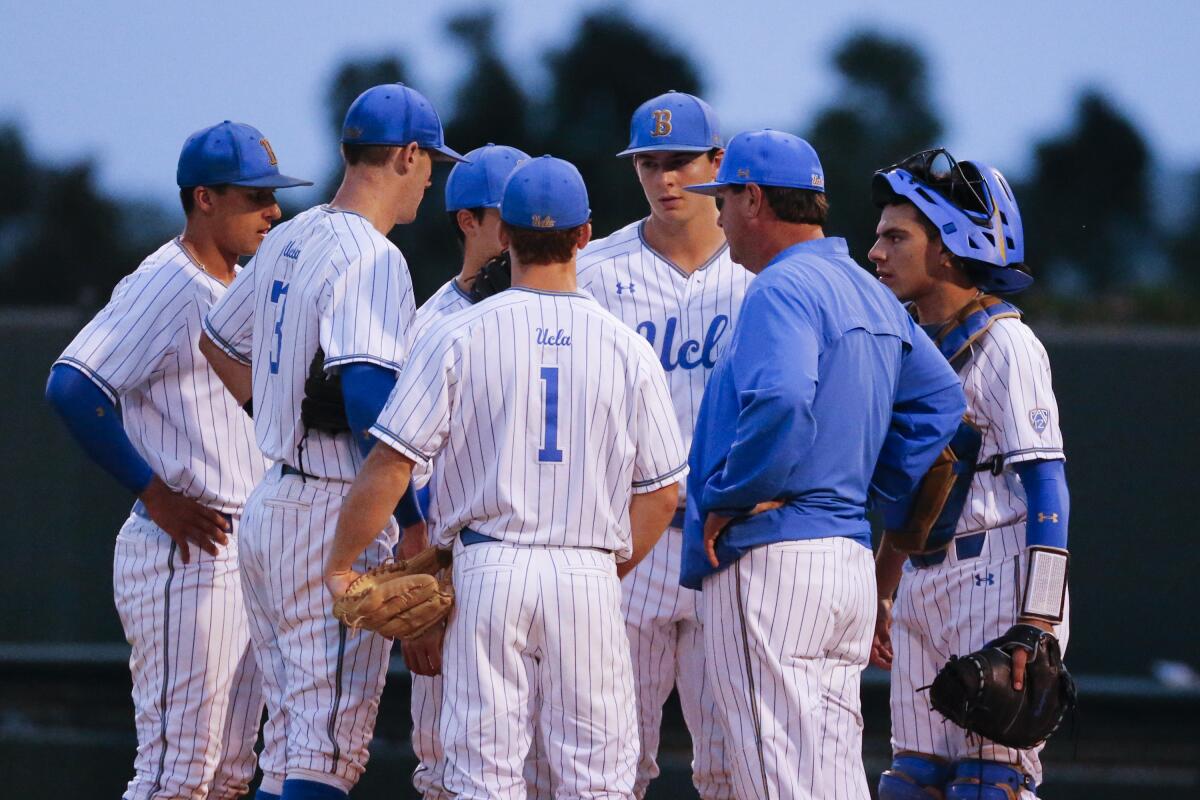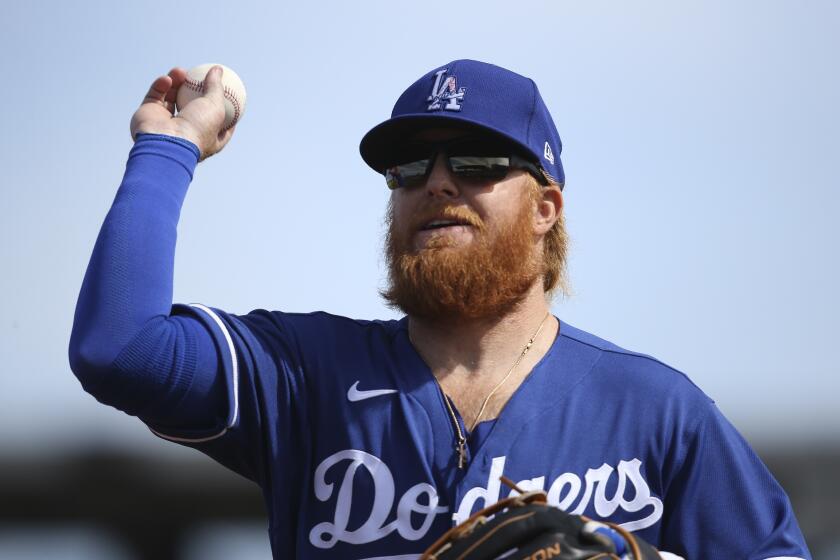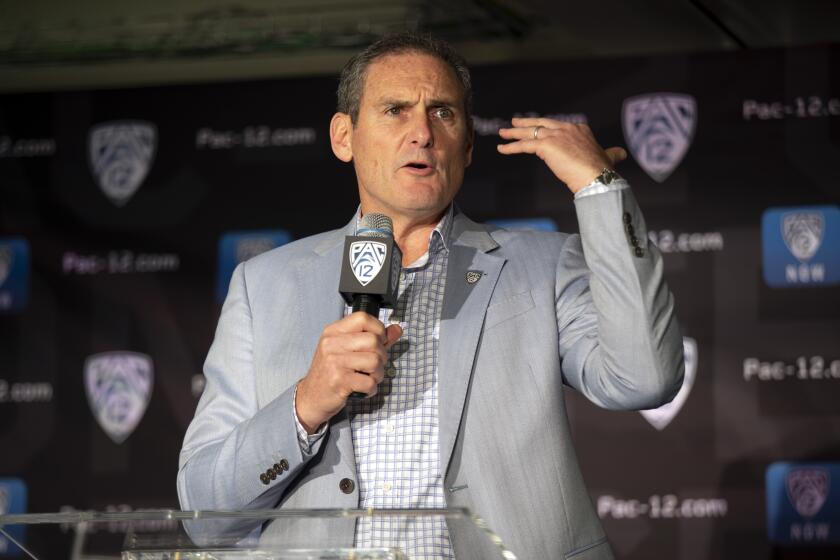Shortened MLB draft will create a roster logjam for college teams

- Share via
Their sport won’t return to action until next February, but repercussions from the coronavirus crisis already have college baseball coaches bracing for a potentially seismic impact.
Usually, college baseball serves as a river connecting the amateur and professional ranks, ferrying players to MLB clubs in a strong and steady stream. But when the league, in an unprecedented cost-saving move, downsized the 2020 MLB draft from 40 rounds to five, it was as if a hastily built dam had suddenly clogged the whole system.
By the time the two-day event ends June 11, only a fraction of draft-eligible college and high school prospects will be offered professional contracts. The rest will be backlogged in a reservoir of talent, threatening to flood college baseball with more players than it is designed to handle.
“In the big picture, it’s something that we’ve never calculated or prepared for,” UCLA coach John Savage said: “It’s so fluid, we’re changing our roster and the looks of it literally day to day. It could lead to mass confusion here in a month or so.”
The problem is unique to baseball, the only NCAA sport whose major pro league drastically altered its amateur draft this summer. Even under normal circumstances, managing college rosters is “a shell game,” USC coach Jason Gill said, forcing coaches to sign recruiting classes months before knowing how many of their draft-eligible players (juniors and 21-year-old sophomores) might be drafted and signed.
The MLB draft will be just five rounds and held virtually. Undrafted players can’t sign for more than $20,000, meaning many likely won’t turn pro for now.
Add in a 2020 draft one-eighth its normal length and a meager $20,000 signing bonus cap for undrafted players, and “all those predictions are getting fouled up across the country,” Gill said. “There’s a lot of layers.” The logjam will swell even larger because the NCAA will allow 2020 seniors in spring sports to return in 2021.
Ballooning college rosters could stretch programs’ resources thin. The limit of 11.7 scholarships per team is not expected to change even though scholarship money earmarked for incoming freshmen may instead go to returning players. An overcrowded transfer market could exceed demand, potentially leaving some players with nowhere to go.
And if the NCAA doesn’t adjust its strict roster rules, which currently cap baseball teams at 35 players and allow only 27 to receive scholarship money, many coaches could be forced to cut players just to remain roster-compliant.
“There’s no way a majority of us can get under 35,” Gill said. “There’s going to be some phone calls that have to be made to families that are going to be unfortunate.”
Gill and Savage believe their programs will exceed the 35-man roster max by only a handful of players, depending on how the draft shakes out. But they know other schools could face rosters as large as 45 or 50 next year.
“That’s what we’re trying to get the NCAA, as a coaches group, to understand. If you don’t make some relief legislatively, there are going to be kids run off of rosters through no fault of their own.”
— Tracy Smith, Arizona State baseball coach
“Can you imagine your son getting a call in July — after they’ve been committed to a school for three years and signed a national letter of intent back in November — that not only do they not have a scholarship but they don’t have a spot on that team?” said Craig Keilitz, executive director of the American Baseball Coaches Assn., which issued recommendations that the NCAA temporarily waive the 35-man roster cap and increase the maximum number of scholarship-eligible players from 27 to 32.
Keilitz continued: “I mean, that’s reality unless we make this change.”
Arizona State coach Tracy Smith echoed similarly dire predictions.
“If [the NCAA] says, ‘We’re not going to do anything,’ you’re going to see a massive amount of kids enter the NCAA [transfer] portal on the suggestion of coaches,” Smith said. “That’s what we’re trying to get the NCAA, as a coaches group, to understand. If you don’t make some relief legislatively, there are going to be kids run off of rosters through no fault of their own.”
The expectation within the sport is that the NCAA will approve the ABCA’s baseline proposals. But after the NCAA Division I Council failed to address any baseball management issues during its latest meeting May 20, the earliest that rule changes can be considered is at the council’s next meeting, June 17 — six days after the draft is completed.
“College baseball needs clarity,” said Kendall Rogers, co-managing editor of D1Baseball.com. “You can get away with not voting on it last week. But if you’re not voting on roster issues by June 17, you’re going to have a lot of kids and a lot of coaches in limbo leading up to school.”
Pac-12 Commissioner Larry Scott said that student-athletes would be safer and in a healthier situation if they were on campus in the summer.
Rule changes won’t erase all complications, either. Rogers expects the transfer portal, which he said had already seen 1,000 entrants since January, to “explode when the draft is over” — especially if more schools eliminate their baseball programs, as Bowling Green and Furman did this month.
Junior colleges stand to be a big benefactor from the shortened draft and Division 1 logjam. High school players who expected to be drafted, and signed, after the fifth round could play at a junior college and be draft-eligible in 2021. If they attend a four-year school, they wouldn’t be draft-eligible until 2023.
Yet, Rogers said, “there are going to be a lot of kids that will end up having to hang up their cleats and not play baseball. There’s going to be a lot of careers ended.”
Loyal upperclassmen role players will have few options because they are too old to transfer to junior college and unlikely to be desired by other programs.
“Running juniors off and seniors off, it’s just — boy oh boy,” Savage said, at a loss for words. “That’s what I fear.”
College baseball could benefit in the long run from a reduced draft and expected minor league contraction. But there will be a short-term cost first, one that will affect almost every player, coach and program.
“The silver lining to this whole craziness [is that it] could change things for the better for college baseball, who knows?” Keilitz said. “But I wish we didn’t have to go through it.”
More to Read
Go beyond the scoreboard
Get the latest on L.A.'s teams in the daily Sports Report newsletter.
You may occasionally receive promotional content from the Los Angeles Times.













